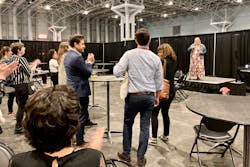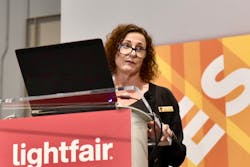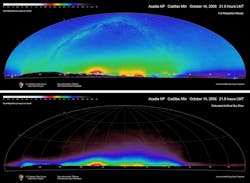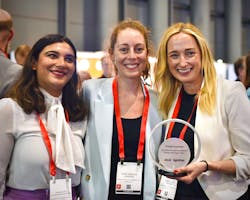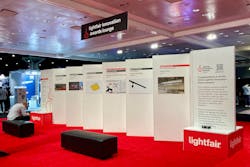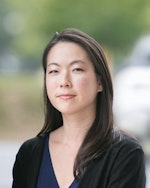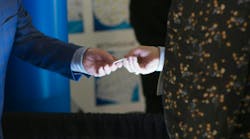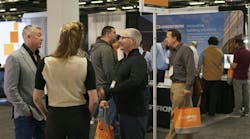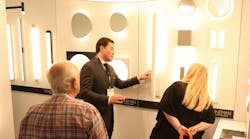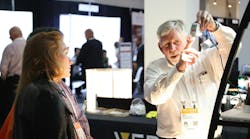The buzz of New York City complemented the activity inside the Javits Center during this year’s LightFair, held May 21-25. According to a post-show press release, the trade show and conference had 320-plus exhibitors, 100-plus conference sessions, 30-plus on-floor events, and more than 11,500 event registrants from 70 countries and 49 states. “LightFair continues to raise the bar for breadth and depth of education and exhibits, cementing its place in the lighting industry calendar as a must-attend event,” show director Dan Darby said in the release.
LightFair is jointly owned by the International Association of Lighting Designers (IALD), the Illuminating Engineering Society (IES), and International Market Centers, the last of which recently rebranded under the name ANDMORE. This year, IALD and IES developed the on-floor programming and educational sessions, many of which covered topics and talking points in sustainability, energy efficiency, smart lighting and controls, occupant health and well-being, and diversity, equity, and inclusion. “The IES was blown away by the energy at LightFair,” said IES CEO and executive director Colleen Harper in the press release. “The new components that debuted this year, including the strong conference program that truly reflected IES educational priorities—the curation of which was led by IES Director of Education and Standards, Brienne Musselman—sets us up for an incredibly bright future.”
Keynote speaker highlights
Musselman was instrumental to engaging LightFair keynote speaker Karen Treviño, chief of the National Park Service (NPS) Natural Sounds and Night Skies Division, whom Musselman introduced on the show-floor stage. During her presentation, “Chasing Darkness into the Light,” Treviño discussed NPS’ enormous oversight, which includes 424 parks over 84 million acres of land—80% of which is managed as wilderness under the Wilderness Act of 1964—and 1,041 campgrounds that serve 331 million visitors annually. As such, NPS staff and visitors are critical in preserving night skies.
Treviño’s keynote described several of her division’s high-impact initiatives and had a couple calls to action to the lighting community. First, the NPS Organic Act, first enacted in 1916, mandates that the NPS should “conserve the scenery and the natural and historic objects … therein and to provide for the enjoyment of the same in such manner and by such means as will leave them unimpaired for the enjoyment of future generations.” This act led to NPS management policy 4.10 Lightscape Management, which states NPS will “minimize light that emanates from park facilities, and also seek the cooperation of park visitors, neighbors, and local government agencies to prevent or minimize the intrusion of artificial light into the night scene of the ecosystems of parks” to “prevent the loss of dark conditions and of natural night skies.”
“This is not always easy,” Treviño said, citing two primary challenges: educating people, including NPS’s own park staff, and countering the “brighter is safer” false paradigm. If LEDs are used correctly, she continued, they can help reduce light pollution; if used incorrectly, LEDs can make things worse. “Very few people use LEDs correctly,” she noted.
In 2021, NPS partnered with IES to help prioritize dark sky education programs and develop lighting standards and best practices for parks and protected areas. NPS is also working with gateway communities that border nation parks to become more dark sky friendly, such as Lake Mead National Recreation Area, in Arizona and Nevada, which is a mere 30-minute drive from one of the planet’s brightest cities, Las Vegas. NPS has diligently taken photometric measurements at more than 380 sites in the past 15 years to measure sky glow.
NPS is working with NASA to create a web-based tool to educate park managers on the impact of anthropogenic light and noise animals.
Treviño cited Signify (formerly Philips) for donating experimental lighting to help reduce electric light at Grand Teton National Park, where bats were developing white nose syndrome from clustering around the insects clustering around exterior fixtures. She also cited Musco Lighting for providing night-sky and wildlife-friendly, culturally accurate lighting at several NPS sites, including Acadia National Park, the White House, and Mt. Rushmore.
Now NPS is challenged with analyzing and applying the photometric data it has collected, and with seeking technology that can remotely control lighting, including brightness and color temperature, over massive swaths of land. Treviño noted that organizing the data will likely require artificial intelligence and machine learning-powered tools, and she welcomed any company that can help with data analysis or with providing advanced lighting controls to contact her office.
Immersive Lighting Installations
A show-floor experience new to LightFair this year was the Immersive Lighting Installations (ILI)—seven booth-sized interactive and engaging installations that were created by designer/exhibitor teams organized by IALD and IES. Each team presented a unique spin on the ILI theme “Circular Economy” and commonly used recycled, salvaged, and upcycled materials and products, such as paper, bamboo, and LED panels, that would be recycled or reused post-LightFair. The displays generated a lot of foot traffic and interest from trade show attendees. On the opening day of the Light Flor trade show, May 23, a panel of judges from IALD selected the “Seeds of Light” installation from manufacturer Traxon e:cue and lighting design firm Tillotson Design Associates as the best overall winner.
Experience the other six IAL Immersive Lighting Installations on Architectural SSL's Instagram account:
- "Activate the Circular Economy" by One Lux Studio and Lamp (Experience Brands).
- “The Image Left, Behind” by Fisher Marantz Stone and Focal Point Lights.
- "Less, Please" by Arup and Casambi in collaboration with ERCO.
- "Net Transformation" by CM Kling + Associates and Boca Lighting and Controls
- "Out of the (Light) Box" by The Lighting Practice and Cooledge Lighting.
- "Renewal" by HLB Lighting Design and Lumenpulse.
Products
As expected, the show floor was teeming with interesting products and technologies, including decorative lighting, controls, building management software, and electric vehicle charging storage systems. A few dynamic products were popular draws among attendees. Stay tuned to read more on a few products we saw.
This year marked the last of back-to-back annual LightFairs as North America’s largest architectural and commercial lighting trade show and conference is switching to a biennial schedule moving forward. Dates and the location for LightFair 2025 will be determined based on feedback from a post-show survey of 2023 exhibitors and attendees, according to the press release. “We listened to the industry to go biennial and it doesn’t stop there,” Darby said. “We will listen to feedback from the surveys and create a plan for 2025 to best suit industry needs.”


